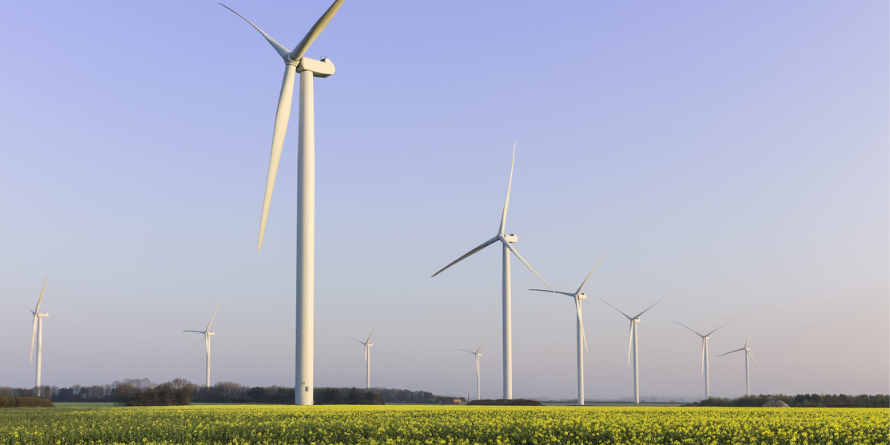Posted on: 16/09/2024
The Contracts for Difference (CfD) scheme is the government’s flagship scheme for driving the growth of low carbon electricity generation. On 3rd September, the results of the sixth allocation round (AR6) were announced, revealing a record-breaking number of successful renewable energy projects, marking a significant milestone in the UK's journey towards a greener energy future.
In this blog, James Clark, Business Development Manager and host of our recent CfD webinar, explores the key takeaways from the AR6 results, including what these results mean for the future of the CfD scheme and the broader energy landscape.
The Evolution of the CfD Scheme
The CfD scheme was established in 2014, and, in the decade since its introduction, has played a key role in the dramatic expansion of renewable energy, to now provide more than 40% of Great Britain’s electricity generation to date.
Designed to incentivise investment in renewables, the scheme has continually adapted to meet the UK's evolving energy needs and accelerate progress toward the 2030 net zero targets. One of the most significant recent changes followed the election of the Labour government, which injected an additional £500 million into this year's CfD auction. This boost, spread across the three technology pots, brought the total AR6 budget to a record £1.5 billion, resulting in a landmark auction.
Key Results of Allocation Round 6
Allocation Round 6 has seen a record of 131 successful clean energy projects, securing just over 9.6GW of capacity. This is more than double the capacity secured within the previous allocation round and increases the total capacity on the scheme by more than 25% - enough to power the equivalent of 11 million homes annually.
Pot 1: Established Technologies
115 of these contracts were secured by established technologies in Pot 1, exceeding the total delivered across all pots in Allocation Round 5. These contracts, set for delivery in 2026 and 2027, were split across two technologies: Solar and Onshore wind.
Solar dominated Pot 1, with 3.3GW across 93 contracts, and secured a strike price of just over £50/MWh, £3 higher than in AR5. This significant increase in new solar capacity is expected to cause increased price cannibalisation during the day, which could lead to deeper capture price discounts for baseload energy. It may also trigger more frequent periods of negative pricing, making co-located battery storage solutions increasingly vital to shift loads and prevent curtailment during these periods.
The remaining 22 contracts in this pot were secured by onshore wind projects with just under 1GW of capacity, 33% less than in AR5. The majority of these sites are based in Scotland, reflecting the ongoing challenges around planning permissions in England.
Pot 2: Emerging Technologies
Within Pot 2, 7 contracts were secured following a similar trend to Pot 1, with only two technologies successfully winning contracts: Tidal Stream and Floating Offshore Wind.
A total of 6 tidal stream projects, providing a combined 28MW of capacity, were awarded at a strike price of £172/MWh. The remaining contract went to Green Volt, the only floating offshore wind project, with a strike price just under £140/MWh and a delivery date set for 2028.
With a capacity of 400MW, Green Volt will be the largest floating offshore wind project in the world—twice the size of Europe’s current total installed floating wind capacity. This makes it a standout success in this allocation round.
Pot 3: Offshore Wind
In Allocation Round 6 (AR6), offshore wind made a notable return to its own dedicated pot, securing the largest share of capacity among all technologies. A total of just over 4.9GW was awarded across nine projects. Of these, only two were entirely new, contributing nearly 3.4GW of capacity expected to deliver by 2028. The remaining capacity, around 1.6GW, comes from seven "permitted reduction" projects scheduled for delivery in 2027.
The concept of permitted reduction, introduced in AR6, allows developers with existing CfD contracts to reduce their initial capacity by up to 25% and re-bid that portion as a standalone project to secure a higher strike price.
The two new offshore wind projects secured strike prices just under £59/MWh, nearly half the rate achieved a decade ago in AR1, though still higher than the prices seen in AR4. This reflects the rising CAPEX costs, but also highlights the increased stability of offshore wind as an established technology. Meanwhile, permitted reduction projects secured slightly lower strike prices, at just over £54/MWh—a 45% increase from their original AR4 contracts.
While the AR6 results mark a significant recovery from the failure of AR5, an equivalent amount of offshore wind capacity failed to secure contracts, leaving those projects to wait and try again in next year’s auction.
Next Steps for CfD Projects
It’s excellent to see so many successful bidders in this year’s auction, particularly in Pot 1, offering more support to the largely independently owned solar and wind projects. Independent generators are currently leading the way when it comes to adding capacity, and they will continue to play a crucial role as the generation mix evolves to meet the UK’s energy security, decarbonisation and net zero targets.
All successful projects have one year to take a Final Investment Decision, deciding whether or not they would like to go ahead with the development of the project, and upon making this decision many need to secure a viable route to market.
How SmartestEnergy can help
As one of the UK’s leading purchasers of independently generated renewable electricity, we have a wealth of experience in providing profitable and effective solutions to a wide range of renewable energy generators across all technology types.
Our Contracts for Difference Power Purchase Agreements (CfD PPAs) align with the commercial terms of your CfD commitment, providing you with a viable route to market and a bankable partner. With a flexible framework, we can support the project’s transition from the Commercial Operations through to the CfD Commencement date, providing generators with up to 15-year discounts to the Intermittent Market Reference Price (IMRP).
Talk to our energy experts!
Reach out to our expert generation team at [email protected] to discuss the auction results and explore your route to market options.
And, if you missed our recent webinar, catch up with the recording, to delve into further insights into the future of the CfD scheme.

 United States
United States Australia
Australia






